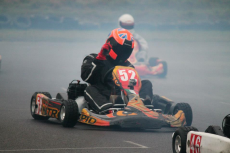
In go-karting, or kart racing, drivers as young as eight race around a track and compete to be the first past the post. This is the simplest form of motor racing, yet has been an important stepping stone for many high profile Formula One racers, such as Fernando Alonso, Michael Schumacher, Ayrton Senna and Lewis Hamilton.
Karting can be both a leisure and recreational activity – the kind of thing you do on holiday vs. an extremely competitive sport. The competitive side to karting began in the 1950s when motor sport enthusiasts decided they wanted to make the thrill of racing available to children. They started with homemade machines, created from lawnmower engines and simplistic steering equipment. Now, however, kart engine sizes can range from 80cc to 250cc and come as either two-stroke (more popular) or four-stroke. Basically, they’ve come a long way since their origins in the lawnmower.
There are three main types of competitive karting:
SPRINT KARTING – This is the most common type of racing. It involves drivers competing on twisty tracks ranging from 400m to 1500km in length.
ROAD RACING KARTING – This type of karting reaches higher speeds than in sprint karting as they take place on larger tracks with longer straights.
SHIFTER KARTING – These karts use a sequential gearbox, which combines the gearbox and the clutch to make changing gear both easier and quicker, and are mainly raced on sprint tracks.
Drivers in karting have to wear abrasion and flame-proof suits, helmets (usually with neck support), driving gloves and optional rib protectors when they race.
Competitors have to be physically fit with accurate steering, cornering, overtaking, braking and acceleration. They must also be mentally tough and determined to win.
If you have a love of all things speed and adrenaline, karting is probably the sport for you. Look up tracks in areas near to you and give it a go… there might be a secret star racer hidden inside!

0 Comment:
Be the first one to comment on this article.